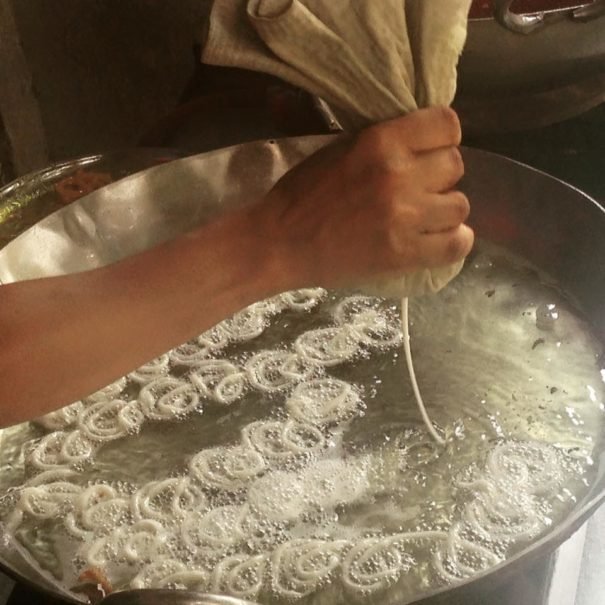
A Man With a Sizzling Wok is Always Good to Find

A Man With a Sizzling Wok is Always Good to Find
Jalebis in Bangalore
The spring equinox that marks the Persian New Year is also celebrated in India, by the Parsi community.
India’s Parsis predate the country’s other Zoroastrian community, the Iranis, by several centuries. The legend of that first wave of Persian migration in the eighth century goes like this: fleeing persecution in their home country, they arrived on the shores of Gujarat on the west coast of India seeking asylum, only to be told there was no room. The king sent a glass of milk filled to the brim to signify his kingdom could accommodate no refugees. But a tenacious Zoroastrian priest added a pinch of sugar and sent the tumbler back, an unspoken promise that the Parsis would assimilate to their new home like sugar into milk, only adding to the sweetness of life in their host country. And the Parsis did integrate seamlessly, assuming the native dress and adopting local traditions while still retaining their distinct culture and faith.
Many Parsi culinary traditions are unique, but there is no denying their host culture’s influence—such as a strong sweet tooth. Most Parsi Nowruz celebrations feature the jalebi, a maze-like spiral of flour-batter, deep-fried and soaked in sugar syrup. The jalebi’s origins are unclear, but many trace its roots to Persia, from the Iranian zulabiā, sweetened with honey and flavored with saffron and rose water.
In the crowded streets of Malleswaram, in Bangalore, if you know where to look, you can find jalebi for breakfast. One morning in the week leading up to Nowruz, as we walked among Malleswaram’s iconic old-school restaurants that serve traditional dosas and idlis, we found what we were looking for: a corner stall with a man and a giant wok. As we walked towards his stall, we felt the heat radiate off the spluttering oil in the pan. He saw us approach and swung into action. Picking up what looked like a large handkerchief filled with batter, he expertly motioned circles in the air, over the oil. A steady stream of batter flowed into the oil below, which he shaped like pretzels. In under a minute he had made close to 40 of them.
It was hard to tear our eyes away from the mesmerizing pattern of his movement. The batter sizzled in the oil. As it changed color, he used a large slotted spoon to lift the roundels out of the oil and drop them into another wok filled with sugar syrup. He let them rest a moment, before ceremoniously placing them on a scratched blue plate.
Jalebis pair nicely with thickened milk, rabdi, or vanilla ice cream, and even custard. But many, like me, believe that they taste best on their own, still hot and crisp from the wok.